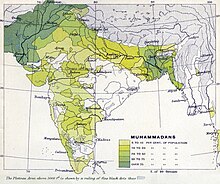
Back نظرية الأمتين Arabic দ্বি জাতি তত্ত্ব Assamese দ্বিজাতি তত্ত্ব Bengali/Bangla Zwei-Nationen-Theorie German Teoría de las dos naciones Spanish نظریه دو ملت Persian Théorie des deux nations French द्विराष्ट्र सिद्धांत Hindi Teori dua bangsa ID ದ್ವಿ-ರಾಷ್ಟ್ರ ಸಿದ್ಧಾಂತ Kannada

The two-nation theory was an ideology of religious nationalism that advocated Muslim Indian nationhood, with separate homelands for Indian Muslims and Indian Hindus within a decolonised British India, which ultimately led to the Partition of India in 1947.[1] Its various descriptions of religious differences were the main factor in Muslim separatist thought in the Indian subcontinent, asserting that Indian Muslims and Indian Hindus are two separate nations, each with their own customs, traditions, art, architecture, literature, interests, and ways of life.
Subsequently, it was used by the All India Muslim League to justify the claim that the Muslims of India should have a separate homeland with the withdrawal of British rule from the Indian subcontinent.[2] The assumption of the Muslims of India of belonging to a separate identity and having a right to their own country, also rested on their pre-eminent claim to political power that flowed from the experience of Muslim dominance in India, while simultaneously it made identification with the former imperial Muslim power an essential part of being Muslim.[3]
The theory was adopted and promoted by the All-India Muslim League and Muhammad Ali Jinnah and became the basis of the Pakistan Movement.[4] The Two-Nation theory argued for a different state for the Muslims of the British Indian Empire as Muslims would not be able to succeed politically in a Hindu-majority India; this interpretation nevertheless promised a democratic state where Muslims and non-Muslims would be treated equally.[5] The two nation theory sought to establish a separate state for Indian Muslims from the northwestern provinces and Bengal region of colonial India.[6] Pakistan claims to be the inheritor of the traditions of Muslim India, and the heir of the two-nation theory.[7] Hindu Mahasabha under the leadership of Vinayak Damodar Savarkar and Rashtriya Swayamsevak Sangh (RSS) supported the Two-nation theory. According to them, Hindus and Muslim cannot live together so they favour India to become a religious Hindu state.[8]
Opposition to the two-nation theory came chiefly from Hindus, and some Muslims.[9][10] They conceived India as a single Indian nation, of which Hindus and Muslims are two intertwined communities.[11] The Republic of India officially rejected the two-nation theory and chose to be a secular state, enshrining the concepts of religious pluralism and composite nationalism in its constitution.[12][10] Kashmir, a Muslim-majority region three-fifths of which is administered by the Republic of India, and the oldest dispute before the United Nations, is a venue for both competing ideologies of South Asian nationhood.
- ^ Bhatti, Safeer Tariq (3 December 2015). International Conflict Analysis in South Asia: A Study of Sectarian Violence in Pakistan. UPA. p. xxxi. ISBN 978-0-7618-6647-3.
The religious nationalism sentiment is based upon the two nation theory that Hindus and Muslims are of two separate religious communities and separate nations.
- ^ Cite error: The named reference
khan1940was invoked but never defined (see the help page). - ^ Farzana Shaikh (2018). Making Sense of Pakistan. Oxford University Press. p. 15. ISBN 978-0-19-092911-4. Archived from the original on 25 March 2023. Retrieved 30 March 2023.
- ^ O'Brien, Conor Cruise (August 1988), "Holy War Against India", The Atlantic Monthly, archived from the original on 28 January 2021, retrieved 20 August 2014 Quoting Jinnah: "Islam and Hinduism are not religions in the strict sense of the word, but in fact different and distinct social orders, and it is only a dream that the Hindus and Muslims can ever evolve a common nationality.... To yoke together two such nations under a single state ... must lead to a growing discontent and final destruction of any fabric that may be so built up for the government of such a state."
- ^ Carlo Caldarola (1982), Religions and societies, Asia and the Middle East, Walter de Gruyter, pp. 262–263, ISBN 978-90-279-3259-4,
They simply advocated a democratic state in which all citizens, Muslims and non-Muslims alike, would enjoy equal rights.
- ^ Chakrabarty, Bidyut; Pandey, Rajendra Kumar (10 July 2009). Modern Indian Political Thought: Text and Context. SAGE Publishing. ISBN 978-93-5280-189-3.
Conceptualising Pakistan in a two nation theory format, Iqbal offered a map of the redistribution of territory forming a Muslim state comprising the north-west part of India and Bengal (Datta 2002: 5037).
- ^ Satish Chandra (1996), Historiography, Religion, and State in Medieval India, Har-Anand Publications, ISBN 9788124100356, archived from the original on 22 April 2023, retrieved 28 March 2023
- ^ Bapu, Prabhu (2013). Hindu Mahasabha in Colonial North India, 1915-1930: Constructing Nation and History. Online access with subscription: Proquest Ebook Central. Routledge. p. 76. ISBN 978-0-415-67165-1.
I have no quarrel with Mr. Jinnah's two-nation theory. We, Hindus, are a nation by oursleves and it is a historical fact that Hindus and Muslims are two nations.
- ^ Cite error: The named reference
Rabasa2004was invoked but never defined (see the help page). - ^ a b Ali, Asghar Ali (2006). They Too Fought for India's Freedom: The Role of Minorities. Hope India Publications. p. 24. ISBN 978-81-7871-091-4.
Mr. Jinnah and his Muslim League ultimately propounded the two nation theory. But the 'Ulama rejected this theory and found justification in Islam for composite nationalism.
- ^ Rafiq Zakaria (2004), Indian Muslims: where have they gone wrong?, Popular Prakashan, ISBN 978-81-7991-201-0
- ^ Scott, David (2011). Handbook of India's International Relations. Routledge. p. 61. ISBN 978-1-136-81131-9.
On the other hand the Republic of India rejected the very foundations of the two-nation theory and, refusing to see itself a Hindu India, it proclaimed and rejoiced in religious pluralism supported by a secular state ideology and for a geographical sense of what India was.